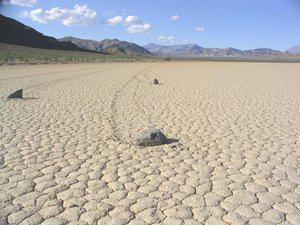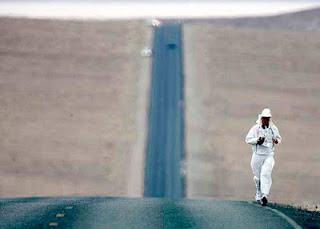
Burning Death Valley
For those of you who, like me, are interested in the extremes of our natural world, there is a new hottest place on Earth: Death Valley, California.1The record was set in the small town of Furnace Creek and now stands at a roasting 134 degrees Fahrenheit (56.7 degrees Celsius). What’s unusual about this record is that it wasn’t set this month or even this year, but way back in July 1913 (99 years ago). What’s even more unusual is that the new record is lower, less scorching2, than the previous record of 136 degrees measured (not quite as) way back in 1922 at El Aziziya, Libya. As I’ve written about before, this 90-year-old record has been dubious from the start, and now the World Meteorological Organization (WMO) has invalidated it.Just to be clear, the record for highest temperature refers to air temperature measured in the shade. Temperatures in the sun can rise well above 134 degrees and ground temperatures heated by the sun can be higher still, almost to the boiling point. (In comparison, the hottest bodies of water tend to be merely warm, like bathwater.3) Getting back to El Aziziya, a quick glance at the map shows that it is located not deep in the Sahara where one might expect a record temperature to be recorded, but just 25 miles from the cool Mediterranean and its moderating breezes. This seems like an unusual place for the planet’s high temperature to occur. The WMO determined that the El Aziziya temperature was the result of the weather station being improperly placed on a black tarmac surface with the thermometer too close to the ground, and thus artificially increasing the measured high temperature. Further, the measurement was probably misread by an inexperienced record keeper. High temperatures measured before and after 1922 didn’t come close the record, lending support that the 1922 reading was an unlikely anomaly. The upshot is that El Aziziya no longer holds the record.
The Crucible of Death Valley
Death Valley is really hot. On July 11 this year the temperature peaked at 128 degrees, not exactly threatening the record, but close enough to tell you that in summer Death Valley is indeed a burning, fiery furnace, a sun’s anvil.4 But Death Valley is a place of extremes. Not only is it hot, but it’s also the lowest point in the Western Hemisphere, 282 feet below sea level, and the driest place in North America, receiving a little more than two inches of precipitation each year. It’s situated in eastern California and flanked on the east and west by high mountain ranges.5 Moisture from the Pacific Ocean is squeezed out of the air by the mountain ranges to the west of Death Valley, and the dry air heats as it sinks under cloudless skies, baking the desert floor. If your idea of hell is flaming heat, then summer in Death Valley is hell.6
There is a peculiar type of individual that chooses to test themselves in this crucible. Each year 80 or so runners participate in the Badwater Ultramarathon, which is described by the race organizers as the “world’s toughest foot race.” Ultramarathoners are a rare lot. These are endurance runners who take on races of 50, 75, 100 or more miles, running hour-upon-hour (and sometimes day-after-day) through exhaustion, pain, injury, and mental and psychological distress. For the runners, these races become tests of the body and soul. That’s why ultramarathoners will gulp thin air at high altitudes or suffer through frostbite in freezing winter cold or cross the cauldron of Death Valley in July. For most people, the effort required for an ultramarathon passes over the line from personal test and fitness goal to deranged masochism.7

A lonesome Badwater ultramarathoner
And it’s a rare ultramarathoner who can complete the Badwater race within the allotted 60 hours. To do so, you have to run over a 135-mile course across Death Valley and then halfway up the slope of nearby Mount Whitney. The race requires you to grapple with not only the deadly summer heat but lung-busting thin air at high altitude. So how does Death Valley treat these runners? In his winning debut, legendary ultramarathoner Scott Jurek stopped periodically to submerse himself in a man-sized cooler filled with ice water (each runner is attended by a team – the race itself offers no support – with food, water, medical help, emotional and psychological sustenance, and all other logistical support). The heat off the road can reach 150 degrees and actually melt shoe soles and burn feet and calves. The over-like air forces the body into a panic and blood to the extremities, trying in vain to keep the runner’s core from overheating. Dehydration and severe gastro-intestinal distress are par for the course. The conditions are so intense, and the body and mind so stretched, that runners often hallucinate, seeing mirages rise from the shimmering desert. Sounds pleasant doesn’t it?Very few of us will ever run the Badwater race (or anything similar), but the summer conditions in Death Valley are so extreme that if you were left there with no water or relief from the sun, you’d be dead within a day or two.8
A Hotter Place?
No place on earth is hotter than Death Valley in summer, but it’s well north of the tropics and so is actually very mild in the winter. The average December temperature at Furnace Creek is a cool 52 degrees, and the record low is -9 degrees F (-22.8 C). There are other places on Earth that never get a respite from the high heat. Perhaps the hottest place on the planet by average temperature is found Dallol in remote far northern Ethiopia.
Dallol, like Death Valley, sits at the bottom of a deep depression, about 430 feet below sea level, in a dry desert. But unlike Death Valley, Dallol’s latitude is well within the tropics (just 14 degrees north) and so it cooks under an intense sun all year long. There was a salt mining operation at Dallol in the early 1960s. During that time the averageyearly temperature was a suffocating 94 degrees, and the average daily high was 106 degrees. Today Dallol is uninhabited, the salt operation long since abandoned. It’s a place that, like Antarctica, is unfit for man.
Death Valley is home to only a few thousand people. But there are some major cities that experience extreme heat. Here are the record high temperatures for some of these cities: Kuwait, Kuwait (128), Khartoum, Sudan (127), Riyadh, Saudi Arabia (126), Jeddah, Saudi Arabia (126), Basra, Iraq (126), Phoenix, Arizona (122), Baghdad, Iraq (122), Bahrain (122), Doha Qatar (122), Karachi, Pakistan (118), Dubai, UAE (117), Tucson, Arizona (117), Las Vegas, Nevada (117), and Murcia, Spain (117).
---
NOTES:
1. It’s more accurate to note that there is a new highest measured temperature on Earth because there’s no way to verify that the record measured air temperature at one weather station is a record for any time across the entire planet.
2. It would be inappropriate to write that the new record is “colder” than the previous record.
3. The warmest body of water (or the warmest part of the warmest bodies of water) is hard to determine, but candidates include the Red Sea, Persian Gulf, Indian Ocean, and Caribbean Sea. This of course ignores small geo-thermally heated bodies of water like geysers and natural hot springs.
4. Film buffs may recognize these descriptions from dialog spoken in that ultimate desert movie (and cinema masterpiece) Lawrence of Arabia.
5. Here’s a neat piece of geographic trivia: Death Valley, the lowest place in North America is located just 85 miles from Mount Whitney (summit elevation: 14,505 feet), the highest mountain in the contiguous United States.
6. My idea of Hell is closer to Dante’s, a dark frozen waste. So for me hell on earth is to be found in coldest part of Antarctica, like for instance, the Vostok Station. But my ideas aside, summer in Death Valley is hellish.
7. I can recommend Christopher McDougall’s book Born to Run if you’re interested in learning more about what these races entail and what type of personality they attract.
8. The name of the place doesn't lie.

